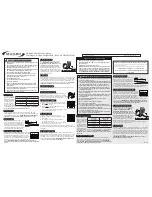
40
HPF24S Series Power Supplies —
P/N 52751:D3 5/11/2010
Power Supply Requirements
Calculating the Battery Size
Table 6.3 contains three columns for calculating current draws. For each column, calculate the
current and enter the total (in amperes) in the bottom row. When finished, copy the totals from
Calculation Column 2 and Calculation Column 3 to Table 6.4 on page 41.
6.4 Calculating the Battery Size
Use Table 6.4 to calculate the total Standby and Alarm load in ampere hours (AH). This total load
determines the battery size (in AH) required to support the power supply under the loss of AC
power. Complete Table 6.4 as follows:
1. Enter the totals from Table 6.3 on page 40, Calculation Columns 2 and 3 where shown.
2. Enter the NFPA Standby and Alarm times. Refer to “NFPA Battery Requirements” on
3. Calculate the ampere hours for Standby and Alarm, then sum the Standby and Alarm ampere
hours.
4. Multiply the sum by the derating factor of 1.2 to calculate the proper battery size (in AH).
Device Type
Calculate Column 1
Primary, Non-Fire Alarm Current
(amps)
Calculate Column 2
Primary, Fire Alarm Current
(amps)
Calculation Column 3
Secondary, Non-Fire Alarm Current
(amps)
Qty
X (current draw)
=
Total
Qty
X (current draw)
=
Total
Qty
X (current draw) =
Total
Main Circuit Board
1
X [ 0.091] =
1
X [ 0.145] =
1
X [ 0.065] =
Power Supervision
Relay
[ ]
X [ 0.025] =
[ ]
X [0.025 ] =
[ ]
X [ 0.025] =
NAC/Output #1
[ ]
X [ ] =
NAC/Output #2
[ ]
X [ ] =
NAC/Output #3
[ ]
X [ ] =
NAC/Output #4
[ ]
X [ ] =
Current Draw from
TB4 Terminals 9 &
10
[ ] =
[ ] =
[ ] =
Sum each column
for totals
Primary Non-Alarm =
Primary Alarm =
Secondary Alarm =
Table 6.3 System Current Draw Calculations













































